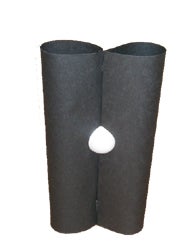| Project IC |
Form Follows Function |
| Objectives |
formal: To introduce the differences between the two-dimensional picture plane and three-dimensional volume and structure. conceptual: to explore how different meanings (or functions) can be supported by varying formal relationships and design. |
| Project Overview | Your challenge is to create a three dimensional volume from a single sheet of paper that is both self-supporting (i.e.stands on its own) and holds or presents a hollow egg. |
|
Project References
|
Pablo Picasso, Ellsworth Kelly, Louise Nevelson, |
| Vocabulary | two-dimensional, three-dimensional, form and content, positive and negative space, ground plane, connection, fasteners, formalism, iconic |
|
Materials
|
construction paper, paper fasteners, raw egg, needle or pin, paper cup. |
| Process |
Preliminary: 1. Before coming to class, review the thematic concept of Art and Technology as found on the website. Also read the discussion "From 2D to 3D" for Unit I. Review the Project References above. Activities: a) experiment with different
methods of folding, fastening, texturing, your paper. Project: Create a three dimensional volume that is both self-supporting (i.e.stands on its own) and holds or presents the blown egg. |
|
Critique Ideas
|
When you have completed your
sculpture, divide into small groups and exchange artworks with another
group from the class. Within your group, work together to respond to each
sculpture in turn. Consider the following 2. Point out any personal symbols the artist used to indicate a particular meaning. 3. Discuss ideas the artwork seems to communicate. After some sharing of interpretations, attempt to state the "message" of the design in one sentence. (This artwork is about. . .) 4. Explain how the shapes, symbols, or other elements of the design support its message. |

